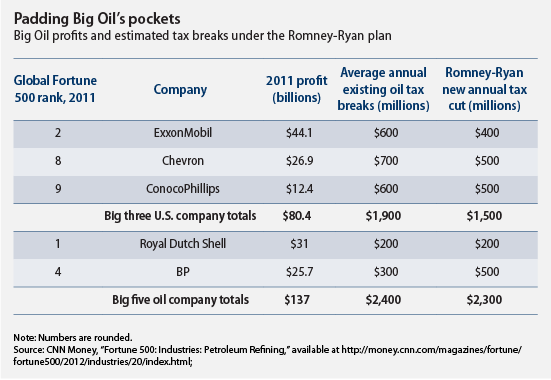Big Oil: Romney's Policies Could Hand Oil Companies Another $4 Billion A Year
 Republican presidential candidate Mitt Romney’s economic plan slashes corporate tax rates while failing to identify a single corporate tax loophole to eliminate. Highly profitable large oil companies that already enjoy lucrative tax breaks stand to receive some of the biggest benefits from Gov. Romney’s plan.
Republican presidential candidate Mitt Romney’s economic plan slashes corporate tax rates while failing to identify a single corporate tax loophole to eliminate. Highly profitable large oil companies that already enjoy lucrative tax breaks stand to receive some of the biggest benefits from Gov. Romney’s plan.The world’s five biggest public oil companies—BP, Chevron, ConocoPhillips, ExxonMobil, and Royal Dutch Shell—would keep special tax breaks worth $2.4 billion each year. And by cutting corporate tax rates, the Romney plan could lower the companies’ annual tax bill by another $2.3 billion, based on an analysis of the companies’ tax expense for 2011. The special tax breaks, supplemented by Gov. Romney’s lower corporate rates, could benefit the oil companies by more than $4 billion annually.
As we will show, these five companies are hardly in need of a tax cut: They earned a combined record profit of $137 billion in 2011 due to high oil and gasoline prices.
Breaking down Gov. Romney’s tax breaks for Big Oil
Gov. Romney’s economic plan proposes to cut the corporate income tax rate from 35 percent to 25 percent—nearly a one-third reduction. That could provide a combined tax cut of at least $2.3 billion annually to the five largest publicly owned oil companies, according to an analysis of their 2011 public financial statements. That includes $1.5 billion for the three domestic oil companies and $800 million for the two foreign-owned companies. Since it is of course impossible to predict their future profits, this estimate is based on their 2011 financial data, including their U.S. federal income tax expense. (See the methodology section for more information.)
In addition, existing oil tax breaks would be protected under Gov. Romney’s plan. Though he has spoken in general terms about broadening the tax base, he has failed to name even one corporate tax loophole he would eliminate. His campaign has specifically criticized President Barack Obama’s efforts to close oil tax loopholes. And his chief energy advisor, oil executive and Romney super PAC donor Harold Hamm, has urged Congress to maintain the oil industry’s special tax breaks.
Preserving Big Oil’s existing tax breaks would save the five companies $2.4 billion annually, according to the Congressional Joint Committee on Taxation. The value of these tax breaks for each company is not public. But using the rough proxy of apportioning them according to the companies’ U.S. revenue, the three American companies receive approximately $1.9 billion of these tax breaks while the two foreign companies receive $500 million.
Under reasonable assumptions, the five oil companies’ total annual tax bills would be $4.2 billion less than they would be without the special tax breaks that Gov. Romney would preserve and without Gov. Romney’s corporate tax rate cut. (This is less than the sum of the estimates of the two elements of Gov. Romney’s plan because of interactions between them—reducing tax rates lowers the value of deductions.)
None of these figures includes the impact of Gov. Romney’s proposals to exempt overseas profits from U.S. taxes or to allow existing overseas profits to be repatriated at a special low tax rate. The three U.S. companies—ExxonMobil, Chevron, and ConocoPhillips—stashed away a combined $76 billion in profits overseas at the end of 2011. Adding in the benefits to the oil companies of these parts of the Romney plan could greatly increase their largess from a Romney presidency.
The oil tax windfall would be the same under the House-passed fiscal year 2013 budget resolution sponsored by House Budget Committee Chairman Paul Ryan (R-WI), which Gov. Romney endorsed. The Ryan budget also lowers the corporate rate to 25 percent while keeping the existing tax breaks for these five companies. Gov. Romney heartily endorsed the Ryan budget plan, saying, “I applaud it. It’s an excellent piece of work, and very much needed.”
The chart below shows the oil companies’ average annual tax breaks and their new cuts under the Romney-Ryan plan in addition to their profits last year.

Big Oil companies are the last ones that should be getting tax cuts
These Big Oil companies don’t need a tax cut. They earned a combined $137 billion in 2011, or $261,000 per minute. Their first-quarter 2012 profits added another $33.5 billion to their coffers.
At the same time, ExxonMobil, Chevron, and ConocoPhillips have a federal effective tax rate (what they really pay) well below the statutory corporate rate of 35 percent, which is the rate on the books. Reuters reported that:
Exxon Mobil paid 13 percent of its U.S. income in taxes after deductions and benefits in 2011, according to a Reuters’ calculation of securities filings. Chevron paid about 19 percent.
Reuters also reported that ConocoPhillips paid an effective federal tax rate of 18 percent last year. These oil companies’ tax rates, Reuters concluded, are “a far cry from the 35 percent top corporate tax rate.”
What’s more, 2011 was not an anomaly for the three largest American oil companies. Citizens for Tax Justice estimated that in previous years, these companies have also paid significantly lower taxes. From 2008 to 2010 ExxonMobil paid an effective federal tax rate of 14 percent, Chevron paid 25 percent, and ConocoPhillips paid 27 percent.
These tax rates partly reflect the $2.4 billion annually in federal tax breaks for the big five oil and gas companies. If these tax breaks are preserved and corporate rates are lowered, oil companies would pay even lower effective tax rates.
Big Oil advocates claim that they need the existing tax breaks to create jobs and increase oil production. But even with these tax breaks, some of these companies have produced less oil and laid off thousands of workers over the past six years. ExxonMobil, for instance, produced 370,000 fewer barrels of oil per day in 2011 compared to 2006—a 14 percent drop.
An analysis by the House Natural Resources Committee Democrats found that “ExxonMobil, Shell, and BP combined to reduce their U.S. workforces by 17,500 jobs between 2005 and 2010.”
The continuation of tax subsidies for Big Oil reflects the industry’s longstanding political influence. One tax break, the deduction for intangible drilling and development costs, dates to 1916—nearly 100 years ago. It will save the big five oil companies nearly $2 billion over the next decade.
Big Oil is backing Gov. Romney with campaign cash
Big Oil is one of the richest, most powerful interests in American politics today. At the end of June, the oil and gas industry donated nearly $1.5 million directly to the Romney campaign according to Opensecrets.com. This is more than five times its donations to President Obama’s campaign.
In addition, big oil and gas companies, their lobbying arm the American Petroleum Institute, and various oil-funded nonprofits have already spent more than $20 million on paid advertising to oppose President Obama’s proposal to eliminate the Big Oil tax breaks, and generate public support for oil drilling off protected coasts and other oil issues too.
Conclusion
Gov. Romney has made cutting domestic programs a pillar of his campaign. He has said that for every federal spending program, he will ask, “Is it so important, so critical, that it is worth borrowing money from China to pay for it?” His plan, following the lead of the Ryan budget, would force huge cuts to critical programs including Social Security, Medicare, and Medicaid. But Gov. Romney is apparently willing to increase the deficit to continue tax breaks for Big Oil companies and cut their taxes even further.
Methodology
We calculated these tax breaks and rate cuts using information in the domestic oil companies’ most recent Securities and Exchange Commission 10-K filings and the foreign oil companies’ 20-F filings, which contain their annual revenue and income tax expense.
Corporations use different methods for calculating income for tax and accounting purposes. Our estimates are based on the financial statements’ reported current U.S. federal tax expense in 2011 for income earned from U.S. operations. The figures reported on tax returns—which are not made public—may differ.
After deductions, large corporations pay the top corporate tax rate on nearly all of their taxable income. Therefore, by reducing the top rate from 35 percent to 25 percent, the Romney tax proposal would reduce these and other corporations’ taxes before credits by approximately 29 percent. Our calculation of the potential tax cut from the reduced rates ignores the effect of credits because they are not publicly disclosed. But if it were to include credits, the estimated tax cut from the Romney plan would be even larger.
The tax reduction estimates under the Romney-Ryan tax proposal are based on 2011 figures. The actual impact of the proposals will depend on corporations’ future performance and other unknown factors.
The estimates of the companies’ benefit from specific tax breaks is derived from the Congressional Joint Committee on Taxation’s revenue estimates for eliminating those tax breaks for the five largest companies, which total $24 billion over 10 years, or an average of $2.4 billion per year. Because the JCT does not report any company-specific tax information, we used a rough proxy—assuming that each of the big five companies receives a share of these breaks in proportion to their 2011 U.S. revenue (except the provision relating to the foreign tax credit, which was divided only among the three U.S. companies). The value of special tax deductions would be lower if the corporate rate is reduced, so in deriving the potential combined tax benefit from the rate cuts and the preservation of tax breaks, we reduced the estimated value of these deductions by 29 percent.
None of the estimates includes the impact of Gov. Romney’s proposals to exempt income from foreign operations from U.S. taxes (i.e., “territorial taxation”) or to allow existing overseas profits to be repatriated at a special low tax rate. The three U.S. companies—ExxonMobil, Chevron, and ConocoPhillips—held $76 billion in profits overseas at the end of 2011.
You can return to the main Market News page, or press the Back button on your browser.

